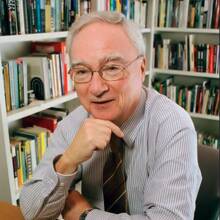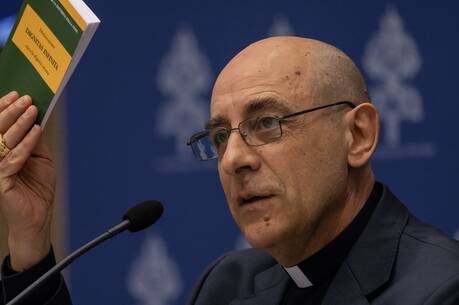‘Is there any place on campus where they recite the Liturgy of the Hours?” The two undergraduates who popped into the sacristy after one of those tiny mid-morning, midweek gatherings for Eucharist in a university chapel took me by surprise. Why would two young women want to squeeze one more event into their busy days? In a larger context, why has the church, century after century, squeezed in the daily cycle of Morning Prayer to Evening Prayer as it marks its yearly progression from birth to death to resurrection? One liturgical season ends, only to start another.
We Christians are captivated by the passage of time: Each moment of earthly life is a sacrament to be cherished as a gift, yet each must pass away before it can be fully savored. With thoughts such as these, age after age the church marks the passage of time by its Liturgy of the Hours.
The Hours, a disturbing and challenging film directed by Stephen Daldry and written by David Hare, responds to the same human need. It dares to examine the wonder of life in its framework of mortality. Most appropriately, the story unfolds in three separate but intertwined time periods, since the questions it raises are perennial. While the discourse has literary and philosophic roots, the film communicates primarily through its images.
Life images abound, most importantly the images of the three women who form the core of the film. In literature and film, it is always the women who personify life, yet too often their responsibility as custodians of life exacts a terrifying price from them. Virginia Woolf (Nicole Kidman), childless, has turned her creative energies toward art, but she suffers from debilitating depression and schizophrenia. As the film opens, she methodically packs the pockets of her coat with stones and walks into the Ouse River. Her suicide in 1941 begins the film’s examination of mortality.
Laura Brown (Julianne Moore) lives in Southern California in the early 1950’s. She has one son and expects another child in four months. Like Woolf herself, Laura has fits of depression and contemplates suicide even as she caresses the new life stirring within her. A neighbor drops in. As they sip coffee in the kitchen, the visitor reveals that she faces surgery to remove a tumor that may be the source of her inability to conceive. “A woman is really a woman only when she is a mother,” the neighbor sobs.
Clarissa Vaughn (Meryl Streep), a successful New York book editor, married a long time ago, but for many years she has been living with Sally Lester (Allison Janney). She has a grown daughter through an anonymous sperm donor. Settled into a stable, supportive relationship, she channels her life-giving energies into caring for Richard Brown (Ed Harris), a prize-winning poet who is dying of AIDS. His crushing regimen of medication and his awareness of imminent death have deepened his own schizophrenia and depression. He tells Clarissa that he keeps on living only to please her.
Virginia Woolf has begun work on her new novel, Mrs. Dalloway, which Laura is reading with great interest. (The title of the film, “The Hours,” was in fact Woolf’s working title in her 1923 manuscript of the novel.) It begins with the line, repeated in the film: “Mrs. Dalloway said she would buy the flowers herself.” Flowers provide a visual motif for the film. In developing this image, both novel and film pick up the theme of the poet Robert Herrick (1591-1674), “Gather ye rosebuds while ye may.” A bud holds the promise of great beauty to come; the flower opens; the petals drop. Herrick continues, “And this same flower that smiles today/tomorrow will be dying.”
But in their dying the flowers bear a message for us. Have we more claim to immortality than they? In the film, we associate each of the three women with the flowers they carefully choose to express their own fragile lives. They have a moment to blossom, but like their bouquets they must ultimately perish. What are they, are we, to make of that undeniable truth?
The fictional Mrs. Dalloway needed to buy flowers to decorate the table for the party she planned, and in the film each of these three women fusses about the meal she will prepare for others. In our symbolic and social universe, a meal is, of course, much more than nourishment; it is communion. The women who give life preserve it through the meals they serve to those they love.
In her distress, Woolf refuses to eat at all, but she sends the maid to London to buy sweets for her sister’s children. Laura struggles in her kitchen. Her 10-year-old son reminds her to grease the pan for the elaborate birthday cake she wants to bake “from scratch” for her husband’s birthday. The cake is a disaster. Compelled to please, she holds back a tear of frustration, dumps her handiwork in the rubbish and tries again. For her, nurturing is no easy task.
Clarissa plans an elaborate dinner party for Richard to celebrate the latest award for his poetry. An accomplished chef, she prepares her “crab thing” with fresh crabs. Richard, however, dashes her plans, and the beautiful meal slides into the garbage, untasted and unappreciated. The imagery becomes even more explicit in the use of eggs in each of the meals. This familiar symbol of new life, used so effectively at Easter, appears in all the food preparation, but it becomes progressively more complex as Clarissa carefully separates yolks from whites in her bare hands. For her, life-giving involves distinctions, precisions and above all great care.
Each of the women lives her life in confinement. Woolf coils up behind her lap desk, compressed by the arms of a huge easy chair and hemmed in by the books and notes that clutter the floor of her study. Laura is surrounded by the appliances and customized Formica countertops in her kitchen. Clarissa repeatedly enters a coffin-sized elevator that takes her from the street to Richard’s loft, from life to death and back again. External circumstances suggest that each woman is quite successful in what she does, but the images tell us they are imprisoned by their lives.
Life-giving finds its natural expression in sex. In three exquisitely delicate scenes, each one involving a kiss, each of the women questions her own sexual identity. Nurturing also has an inward dimension, and the women wonder, if only for an instant, if their relationships have been enough to sustain their own lives. Are they missing something? Do they have regrets for past choices? Can they rewrite their autobiographies? Do they want to?
The composer Philip Glass has provided a musical score of fragile sounds and insistent rhythms. In a fit of whimsy I heard the background music as suggesting a kind of ethereal loom weaving the intricate tapestries of their lives. The cinematographer, Seamus McCarthy, and the designer, Maria Djurkovic, bring us from the rich, muted “Masterpiece Theatre” tones of the Woolfs’ country home to the lurid, plastic primary colors of 1950’s Los Angeles via Technicolor, to the newsprint grays and blacks of Woody Allen’s Manhattan. “The Hours” is a women’s film, but it is best described as handsome rather than pretty.
Ed Harris brings a chilling intensity to his portrayal of Richard, as he rages “against the dying of the light.” Nicole Kidman surprises us by bravely stepping back from her glamour image. In a shapeless dress and with hair drawn into a happenstance bun, she sulks expressionless through sickness and creativity alike, unable to react to her world or to the people who try to love her. She makes us feel Woolf’s loneliness and pain as though it were our own. Meryl Streep and Julianne Moore provide no such surprises. They are simply among the best actors working in film today, and once again they simply do what they do.
Ultimately, the success of this film, any film, rests on its script. David Hare’s adaptation of Michael Cunningham’s 1998 Pulitzer Prize-winning book is near-miraculous. Contemporary authors have moved resolutely beyond strict time sequence and clear cause-and-effect narratives, but even by modern standards, this is a story of extraordinary complexity. Keeping the three strands together, and moving from one to the other without compromising interest in any, strikes me as a masterly achievement. David Hare has created a disturbing “literary” film of ideas that still functions as entertainment.
No, I wouldn’t claim that “The Hours” is liturgy, but in a secular world, it offers a ritual to guide our search for lasting meaning in a world of spectacular impermanence.







